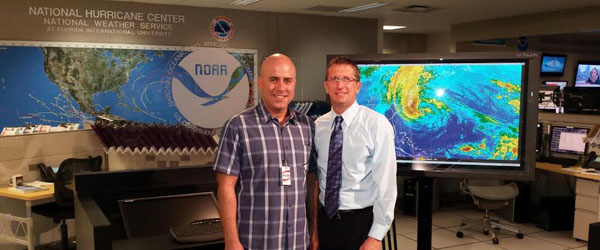Keeping up with storm preparedness in Asbury Park
'As far as forecasting goes, it's all about probability and possibility'
Following a week long course at the National Hurricane Center in Miami, Asbury Park’s emergency management coordinator is even more poised to help guide the city’s decision makers when the next major weather event hits the shore.
The city’s Office of Emergency Management [OEM] coordinator helps physically brings the decision makers together as far as city officials, public works, engineering, social services and other important city departments are concerned, to address issues as per the OEM plan and handle unforeseen challenges as they arise.
Fire Marshall Garrett Giberson, Jr., who was re-appointed to the position of OEM coordinator by Mayor John Moor on Jan. 1, said the course, “Hurricane Preparedness for Decision Makers” focused on ways to share information and what free products and services — like Hurrevac and Slosh, short for Sea, Lake and Overland Surges from Hurricanes — forecasters use to predict when a storm will hit a specific area, how big it will be, how much flooding will take place, the potential for storm surges and overall storm impact.
“As far as forecasting goes, it’s all about probability and possibility,” Giberson said. “
Data entered into the programs comes from buoys and ships at sea, as well as other places, and is gathered by a supercomputer that has a 60 to 70 percent success rate at predicting storm paths.
Situated along the Atlantic Ocean, bordered by Deal Lake to the north and Wesley Lake to the south with Sunset Lake in the middle, Asbury Park’s weakness is that it is surrounded by water, and for a coastal community storm surge is one of the biggest threats a hurricane, tropical storm or a nor’easter presents, he said.
He likened storm surge intensity to pushing water with just your hand as opposed to pushing water with your whole arm submerged near the surface.
“Naturally, you are going to be able to push more water with your arm.”
Moving forward he plans to research the width and slope of the continental shelf in the Asbury Park area, since a shallow slope will potentially produce a greater storm surge than a steep shelf, he said.
Population is another factor.
“Everyone is flocking to the shore, the population from 20 years ago has boomed,” he said.
With the influx of people, increased development due to housing and other needs has reduced the amount of permeable surfaces for natural storm water mitigation. All of these factors come into play when a storm rolls through.
Compared with other shore areas, Asbury Park emerged relatively unscathed after Hurricane Sandy. Giberson largely attributed the city’s good fortune to the fact that the eight to 10 inches of rainfall predicted to accompany the storm, didn’t.
“That really protected us, he said. “We would have suffered more damage if it did.”
Overall, the class provided “a lot of information in a short period of time,” Gibseron said, “but the bottom line is people need to heed warnings from emergency personnel, especially in evacuation situations.”
Federal Emergency Management Agency [FEMA] funding paid the full cost of the trip.
[Photo at top: Giberson, Jr., at left, with Dr. Richard Knabb, director of the National Hurricane Center. Provided provided courtesy of Giberson.]
————————————————————
Follow the Asbury Park Sun on Facebook, Twitter and Instagram.












